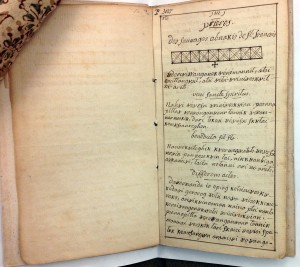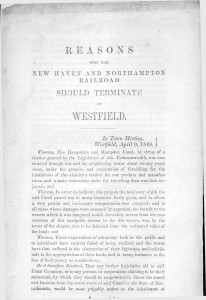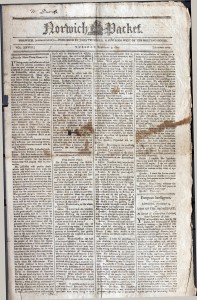Washington’s Will
[Posted by Mollie Scheerer ’14 for AMST 838/438 “America Collects Itself”]
 George Washington died on December 14, 1799 at his Mount Vernon home in Virginia. Upon his death the total sum to which his property and land amounted was $530,000 and was divided among his family, friends, and organizations and causes close to his heart. A copy of it is at the Watkinson published in New York on January 23, 1800 by J. Furman. The original will was printed in Alexandria but the copy in particular at the Watkinson is an authenticated copy as noted by George Deneale, Clerk of Fairfax County Court in Virginia. The original was printed in his office and on the page preceding the title page, Deneale writes that this copy, with the schedule of Washington’s property directed to be sold annexed, is a “True Copy from the Original.” His name was signed at the bottom of every page in the original manuscript but was not included in the copies printed in January of 1800.
George Washington died on December 14, 1799 at his Mount Vernon home in Virginia. Upon his death the total sum to which his property and land amounted was $530,000 and was divided among his family, friends, and organizations and causes close to his heart. A copy of it is at the Watkinson published in New York on January 23, 1800 by J. Furman. The original will was printed in Alexandria but the copy in particular at the Watkinson is an authenticated copy as noted by George Deneale, Clerk of Fairfax County Court in Virginia. The original was printed in his office and on the page preceding the title page, Deneale writes that this copy, with the schedule of Washington’s property directed to be sold annexed, is a “True Copy from the Original.” His name was signed at the bottom of every page in the original manuscript but was not included in the copies printed in January of 1800.
Washington’s will is a window into the life and values of the first President of the United States. He bequeathed his entire estate and everything “real and personal” to his dearly beloved wife, Martha for the remainder of her life. He also gave his property on Pitt & Cameron Streets in Alexandria to her and her family for the rest of its legacy. His love and devotion to his wife during his lifetime is apparent in his will as he respects and trusts her by leaving decisions about his property to her best judgement. Even in his bequests to other family members and friends, much of it has to do with Martha’s well-being after he dies as he wanted to ensure she live the best life possible even without him.
 Perhaps the most interesting and well-known part of his will is the freeing of his slaves, however. In his will he states that after Martha’s death all slaves that he owned were to be emancipated. He waited until after her death to ensure she was taken care of after his passing but both wanted their slaves to find freedom when they were gone. Being the noble man that he was,
Perhaps the most interesting and well-known part of his will is the freeing of his slaves, however. In his will he states that after Martha’s death all slaves that he owned were to be emancipated. He waited until after her death to ensure she was taken care of after his passing but both wanted their slaves to find freedom when they were gone. Being the noble man that he was,
however, he makes sure that they were not released into the free world without being able to land on their feet. He intended for his heirs to make sure the slaves who were too old, young, crippled, or sick were comfortably fed and clothed. For the young slaves with no parents alive, able, or willing to provide for them in freedom, they were to be bound by the court until they were twenty-five years old. He further protected their well-being by forbidding the sale and transportation of any slave out of the commonwealth of Virginia, wanting to keep families together and near their home. The release of his slaves, even in his death, was a powerful statement to make at the time. Washington also wanted to ensure his slaves lead good lives after their freedom, going a step further than most would have done.
Washington also granted immediate freedom upon his death to William, his valet, or whom he called his “Mulatto man.” Again, just as he did for the rest of his slaves after Martha’s death, Washington wanted to ensure William was able to lead a satisfactory life after his master’s death. Due to his position as Washington’s valet, however, William received even more advantageous options. In his will Washington gave William the choice of immediate freedom or, if he so chose, to remain working for Washington’s estate. Washington alludes to William’s situation of being crippled due to accidents that had befallen him rendering him incapable of walking or any active employment. With either option William chose, however, Washington states that he was to receive thirty dollars a year for the rest of his life. Washington’s bequest toWilliam is unlike many master-slave wishes in a last will and testament. Not only is it extremely generous and unprecedented, Washington also speaks to William’s faithful services during the Revolutionary War and their attachment to one another. Another indication of his character, Washington left four thousand dollars to the Trustees of the Academy in Alexandria to support a free school for orphans and the poor annexed to the current Academy. He believed in the power of educating the youth of the United States in strong institutions on our own soil and planned for the establishment of a university in the District of Columbia in his name. There, he intended students to complete their education in all branches of “polite literature; in arts and Sciences, in acquiring knowledge in the principles of Politics & good Government; and…by associating with each other, and forming friendships in Juvenile years, be enabled to free themselves in a proper degree from those local prejudices & habitual jealousies.” Washington also gave a generous endowment to Liberty Hall Academy, later named Washington & Lee University which carries on the President’s legacy and interest in education today.
Although George Washington did not have any children his many nieces and nephews benefited from his will, as did other relatives and friends and their heirs. A great many interesting objects were left for those especially fortunate, such as a gold cane left to him by Dr. Benjamin Franklin to his brother Charles; spy glasses to one of his childhood friends that Washington revealed “constituted part of my equipage during the late war”; and for the Earl of Buchan, the box made out of the legendary Elderslie Oak that sheltered Sir William Wallace after the Battle of Falkirk near Paisley, Scotland. Most of the bequests in Washington’s will are thoughtful and seem personal, again showing his character as well as his respect for those close to him. The physical document itself is interesting as in this edition a schedule and breakdown of Washington’s property to be sold is included. He had a great deal of livestock to be sold including horses, donkeys, mules, cattle, sheep, and hogs totaling to around $15,658. This copy also includes a note from the publisher revealing that the document states it was sealed on July 9, 1790 but the testator omitted the last nine. Although the will states it was finalized that year, it was actually sealed in 1799 just months before Washington’s passing. He also signed the bottom of every page in the original manuscript but his signature was not included in later copies produced. Although the original document is always interesting to explore, sometimes the following copies and editions can be even more revealing about the true nature of the original, as seen with the Watkinson’s copy of George Washington’s Last Will and Testament.







